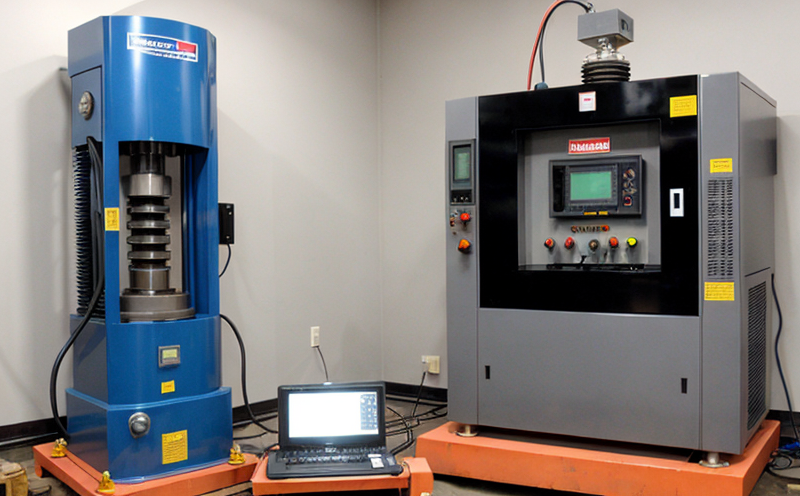Vibration Table Testing for Consumer Electronics
Mechanical shock and vibration testing is a crucial aspect of quality assurance in consumer electronics. This form of stress testing ensures that products can withstand the rigors of real-world conditions, such as transport, handling, and use. The purpose of this test is to evaluate how well components will perform under various levels of mechanical shock and vibration forces.
The testing process involves subjecting a product or component to controlled mechanical vibrations using a vibration table. This equipment simulates the dynamic environment that products may experience during shipment, handling by consumers, and use in different conditions. The test parameters are carefully chosen based on the specific requirements of each product, ensuring that it meets all relevant international standards.
One key aspect of this testing is the preparation of the specimen to be tested. This includes ensuring that the product is free from defects, adheres to design specifications, and has any loose components securely fastened. The test setup also requires precise alignment to ensure accurate results. Once prepared, the product is placed on the vibration table and subjected to a series of predefined shock and vibration cycles.
The testing process follows specific protocols outlined in international standards such as ISO 2631-1:2015 for human exposure to dynamic loads or ASTM E1687-04(2009) for the measurement of mechanical properties. These standards provide a framework for ensuring that the testing is conducted consistently and accurately, leading to reliable results.
After the test, detailed reports are generated, providing insights into how well the product performed under stress. This information can be used by quality managers, compliance officers, R&D engineers, and procurement teams to improve future designs or manufacturing processes. The report typically includes a summary of the test parameters, a description of any defects observed during testing, and recommendations for improvements.
- Why Choose Vibration Table Testing?
- This method provides accurate simulation of real-world conditions.
- It ensures compliance with international standards.
- The test results can be used to improve product design and manufacturing processes.
- Vibration table testing is cost-effective compared to field testing.
- The process can identify potential weaknesses in the product early, saving on repair costs later.
Benefits
The benefits of vibration table testing for consumer electronics are numerous and significant. By subjecting products to controlled shock and vibration conditions, manufacturers can identify potential weaknesses before the product reaches the market. This proactive approach helps in enhancing product reliability and durability, which is crucial for maintaining customer satisfaction and brand reputation.
Another key benefit is the ability to ensure compliance with international standards such as ISO 2631-1:2015 and ASTM E1687-04(2009). Compliance with these standards not only enhances product quality but also opens up opportunities for global market access. By meeting these stringent requirements, manufacturers can confidently enter markets that demand high-quality products.
In addition to enhancing product reliability and compliance, vibration table testing also aids in the development of more robust designs. The insights gained from this testing process help engineers and designers make informed decisions about material choices, component placement, and overall product architecture. This leads to products that not only perform well under stress but are also cost-effective to produce and maintain.
From a business perspective, vibration table testing can significantly reduce the risk of post-market failures. By identifying potential issues early in the development process, manufacturers can avoid costly recalls and repairs, which can have severe financial implications. Moreover, products that pass these rigorous tests are more likely to meet customer expectations, leading to higher sales and increased market share.
Why Choose This Test
Selecting vibration table testing for consumer electronics offers several advantages that are essential for maintaining high-quality standards in the industry. This method ensures that products can withstand harsh environments, enhancing their durability and reliability.
The controlled conditions of a vibration table provide an accurate simulation of real-world stressors. This allows manufacturers to identify potential issues early on, preventing costly errors later in the product lifecycle. The ability to test against international standards such as ISO 2631-1:2015 and ASTM E1687-04(2009) ensures compliance with global market requirements, opening up opportunities for broader market access.
Moreover, the insights gained from this testing can be used to improve product design. Engineers and designers can use the data obtained during these tests to refine material choices and component placements, leading to more robust and efficient products. This not only enhances overall performance but also contributes to cost savings in production and maintenance.
Finally, vibration table testing helps reduce risks associated with post-market failures. By identifying potential weaknesses early on, manufacturers can avoid costly recalls and repairs, which are often financially burdensome. The proactive approach provided by this testing ensures that products meet customer expectations, thereby increasing sales and market share.
Competitive Advantage and Market Impact
Vibration table testing for consumer electronics plays a pivotal role in establishing competitive advantages and driving market impact. By ensuring product reliability and compliance with international standards, manufacturers can confidently launch products into the global market.
The insights gained from this testing process are invaluable for improving product design and manufacturing processes. Engineers and designers can use the data obtained to make informed decisions about material choices, component placement, and overall architecture. This leads to more robust and efficient products that not only perform well under stress but are also cost-effective to produce and maintain.
Moreover, by identifying potential issues early in the development process, manufacturers can avoid costly recalls and repairs. This proactive approach significantly reduces financial implications and enhances customer satisfaction. The ability to ensure compliance with international standards opens up opportunities for broader market access, enhancing product reputation and market share.
In conclusion, vibration table testing for consumer electronics is a critical component of maintaining high-quality standards in the industry. It ensures product reliability, compliance with global market requirements, and enhances overall performance while reducing risks associated with post-market failures. By leveraging these benefits, manufacturers can establish competitive advantages and drive significant market impact.





